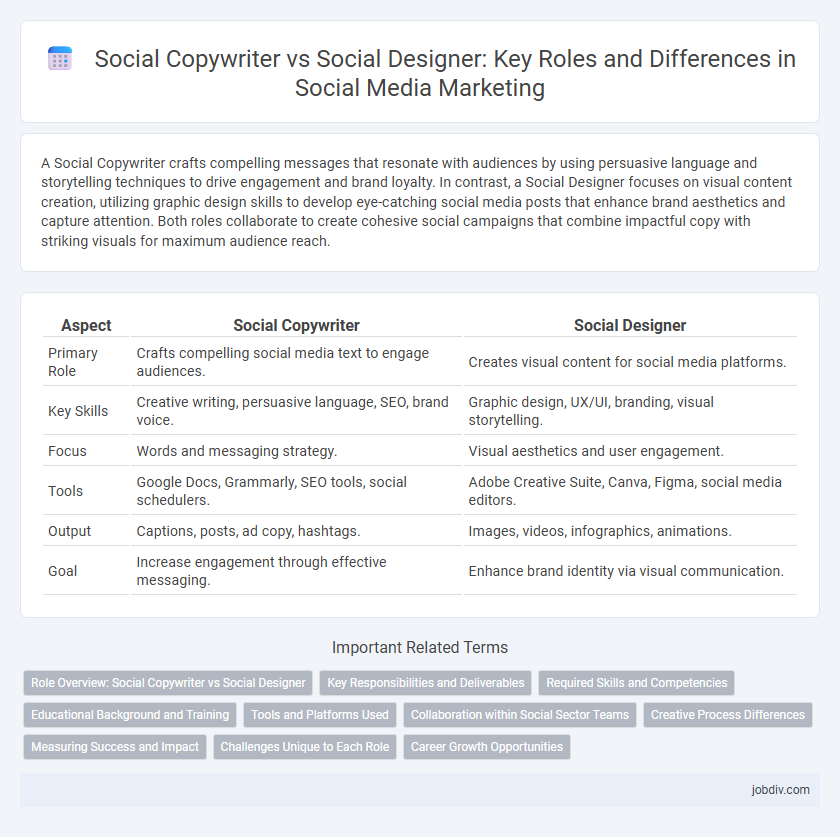A Social Copywriter crafts compelling messages that resonate with audiences by using persuasive language and storytelling techniques to drive engagement and brand loyalty. In contrast, a Social Designer focuses on visual content creation, utilizing graphic design skills to develop eye-catching social media posts that enhance brand aesthetics and capture attention. Both roles collaborate to create cohesive social campaigns that combine impactful copy with striking visuals for maximum audience reach.
Table of Comparison
| Aspect | Social Copywriter | Social Designer |
|---|---|---|
| Primary Role | Crafts compelling social media text to engage audiences. | Creates visual content for social media platforms. |
| Key Skills | Creative writing, persuasive language, SEO, brand voice. | Graphic design, UX/UI, branding, visual storytelling. |
| Focus | Words and messaging strategy. | Visual aesthetics and user engagement. |
| Tools | Google Docs, Grammarly, SEO tools, social schedulers. | Adobe Creative Suite, Canva, Figma, social media editors. |
| Output | Captions, posts, ad copy, hashtags. | Images, videos, infographics, animations. |
| Goal | Increase engagement through effective messaging. | Enhance brand identity via visual communication. |
Role Overview: Social Copywriter vs Social Designer
Social Copywriters craft compelling and engaging text tailored for social media platforms, focusing on brand voice, messaging clarity, and audience engagement through words. Social Designers specialize in creating visually appealing graphics and layouts that enhance social media content, emphasizing aesthetics, user experience, and visual storytelling. Both roles collaborate to ensure cohesive communication by blending persuasive copy with impactful design elements that resonate with target audiences.
Key Responsibilities and Deliverables
A Social Copywriter crafts compelling and concise messaging tailored for specific social media platforms, focusing on audience engagement, brand voice consistency, and content strategy development. Key deliverables include catchy captions, promotional posts, and targeted ad copy that drive clicks and conversions. In contrast, a Social Designer creates visually appealing graphics, animations, and layouts optimized for social media formats, emphasizing brand aesthetics, user experience, and visual storytelling to enhance content impact and shareability.
Required Skills and Competencies
Social Copywriters excel in crafting compelling, brand-aligned messages with expertise in persuasive language, storytelling, and audience engagement techniques essential for social media campaigns. Social Designers possess strong skills in visual communication, including proficiency in graphic design tools, user experience principles, and creating visually appealing content tailored to platform-specific formats. Both roles require a deep understanding of target audience behavior, social media trends, and collaboration abilities to effectively drive brand presence.
Educational Background and Training
A Social Copywriter typically holds a degree in communications, marketing, or journalism, emphasizing skills in persuasive writing and content creation, often enhanced by courses in digital marketing and SEO. In contrast, a Social Designer usually has an educational background in graphic design, visual communication, or multimedia arts, with training focused on visual storytelling, user experience, and design software proficiency. Specialized workshops and certifications in social media strategy further distinguish the distinct skill sets required for each role.
Tools and Platforms Used
Social copywriters primarily use content management systems like Hootsuite and Buffer, alongside writing tools such as Grammarly and Hemingway Editor to craft compelling messages tailored for platforms like Facebook, Instagram, and LinkedIn. Social designers rely on graphic design software including Adobe Photoshop, Illustrator, and Canva to create visually engaging assets optimized for social media channels like Instagram Stories, Pinterest, and TikTok. Both roles leverage analytics platforms like Google Analytics and Sprout Social to measure engagement and refine content strategies.
Collaboration within Social Sector Teams
Social copywriters craft compelling narratives that resonate emotionally and drive engagement, while social designers visually bring these messages to life through strategic creativity. Collaboration within social sector teams enhances campaign effectiveness by combining persuasive language with impactful design, ensuring consistent brand voice and heightened audience connection. Integrating copywriting and design expertise accelerates project timelines and fosters innovative solutions tailored to social impact goals.
Creative Process Differences
Social copywriters focus on crafting compelling, audience-specific messages that drive engagement and brand voice consistency, relying heavily on language nuances and storytelling techniques. Social designers emphasize visual communication through layout, color theory, and brand aesthetics, shaping user experience and emotional response with imagery. Both roles collaborate closely but diverge in the creative process: copywriters ideate content structures and narratives, while designers translate those ideas into visually impactful formats.
Measuring Success and Impact
Measuring success for a Social Copywriter involves tracking engagement metrics such as click-through rates, conversion rates, and audience sentiment from textual content. Social Designers focus on visual impact metrics, including shareability, visual engagement rates, and brand consistency across platforms. Both roles require analyzing social media analytics tools to assess overall campaign effectiveness and optimize future strategies.
Challenges Unique to Each Role
Social copywriters face the challenge of crafting compelling, concise messages that resonate with diverse audiences while maintaining brand voice consistency across platforms. Social designers must balance creativity with functionality, ensuring visual content captures attention and enhances user experience in fast-scrolling feeds. Both roles require adapting to rapidly changing trends and platform algorithms to maximize engagement and drive social media success.
Career Growth Opportunities
Social copywriters specialize in crafting compelling messages that boost brand engagement and drive conversions, enhancing their potential for roles in content strategy and marketing management. Social designers focus on visual storytelling and user experience, opening pathways to creative director positions and UX/UI leadership. Both careers offer significant growth opportunities, with social copywriters leveraging linguistic skills and social designers utilizing visual expertise to advance.
Social Copywriter vs Social Designer Infographic

 jobdiv.com
jobdiv.com